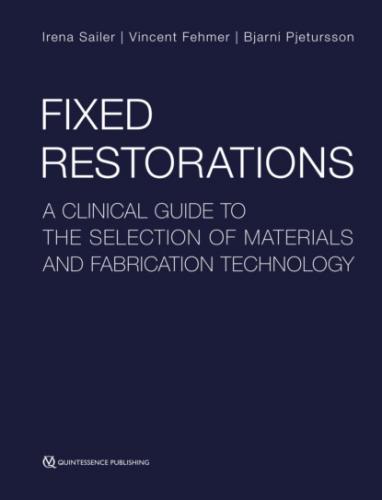Fixed Restorations. Irena Sailer
for the clinical application11. To avoid complications like catastrophic fracture, clinicians and technicians need to be aware of the recommendations by the respective manufacturers.
Five factors need to be considered for the selection between monolithic and veneered restorations:
■ Esthetic factors
■ Position in the dental arch
■ Material-specific limitations
■ Options for surface modification
■ Abrasion/wear properties.
Esthetic factors
The individual characteristics of the remaining dentition used as a reference play an important role for the selection between monolithic and veneered restorations. The more complex the optical properties of the reference teeth, eg, the more internal and superficial structure and staining they have, the more difficult (or even impossible) will be their mimicking with monolithic materials. Multilayer ingots may improve the esthetic appearance to a certain extent12. With very translucent reference teeth, a buccal cut-back of the monolithic restorative material and microveneering needs to be planned13.
With discolored teeth, it has to be considered that all ceramic materials including zirconia may be unable to mask strong discolorations14, if not certain thicknesses of the ceramic can be provided. Monolithic ceramics are, hence, mostly indicated for non-discolored or slightly discolored situations15.
With very discolored abutment teeth, either a more invasive preparation needs to be provided, or a masking of the discoloration with opaque composite materials needs to be performed. This, however, implies a more invasive reduction of the tooth substance to gain space. Alternatively, metal-ceramic restorations may be preferred.
Position in the dental arch
The second factor to be evaluated is the position of the restoration in the dental arch. In posterior regions, highly esthetic results can be achieved with monolithic materials, even more with aid of multilayer ingots. In the posterior area, the application of veneering ceramic can be avoided and the risk for chipping of the ceramic during occlusion and function may be reduced (Fig 1-3-6).
Fig 1-3-6a Occlusal view of the initial situation of a non-preservable second premolar due to a fracture.
Fig 1-3-6b Occlusal view after extraction of the fractured premolar.
Fig 1-3-6c Occlusal view before final impression.
Fig 1-3-6d Buccal view of the initial situation of a non-preservable second premolar due to a fracture.
Fig 1-3-6e Buccal view before implantation of the BLT 4.1 mm implant (Straumann, Basel, Switzerland).
Fig 1-3-6f Final buccal view of the direct screw-retained, monolithic lithium-disilicate restoration based on a titaniumbase abutment (Vario-Base, Straumann) after 3 years of clinical function.
Fig 1-3-6g Radiographic control after 3 years of clinical function.
Fig 1-3-6h and 1-3-6i Final buccal and occlusal view of the directly screw-retained, monolithic lithium-disilicate restoration on the master cast.
Figs 1-3-6j and 1-3-6k Final view of the monolithic lithium-disilicate restoration cemented to the titanium-base abutment with Multilink Hybrid Abutment HO-0 (Ivoclar Vivadent).
Fig 1-3-6l Occlusal view before placement of the direct screw-retained implant restoration.
Fig 1-3-6m Final occlusal view of the direct screw-retained, monolithic lithium-disilicate restoration on a titanium-base abutment (Vario-Base, Straumann), after 3 years of clinical function. Individualized only by the application of ceramic stains and glaze (Ivocolor, Ivoclar Vivadent, Schaan, Liechtenstein).
In patient situations with high smile line and exposure of the posterior maxillary teeth, facial microveneering may be needed for good esthetic integration.
In anterior regions, the current monolithic ceramics do not allow for perfect esthetic outcomes, not even when multilayer materials are used. The facial application of veneering ceramics (microveneering) and stains is, hence, needed for good esthetic results including a cut-back design of the monolithic restoration (Fig 1-3-7).
Fig 1-3-7a Buccal view of the initial situation of a non-preservable central incisor (tooth 11) due to a fracture.
Figs 1-3-7b and 1-3-7c Buccal and occlusal views during implant placement of a regular diameter bone level implant (BLT 4.1 mm, Straumann) guided by a conventional surgical guide.
Figs 1-3-7d and 1-3-7e Buccal and occlusal view before final impression.
Figs 1-3-7f and 1-3-7g Adjustment of the connector in the blue pre-sintered phase.
Fig 1-3-7h Sintered lithium-disilicate crown on the master model before buccal microveneering.
Fig 1-3-7i Application of about 0.4 mm of dentin in the cervical area (Power Dentin A2, IPS e.max Ceram, Ivoclar Vivadent).
Fig 1-3-7j After finalization of the microveneering by the application of Enamal (IPS e.max Ceram, Power Incisal, Ivoclar Vivadent).
